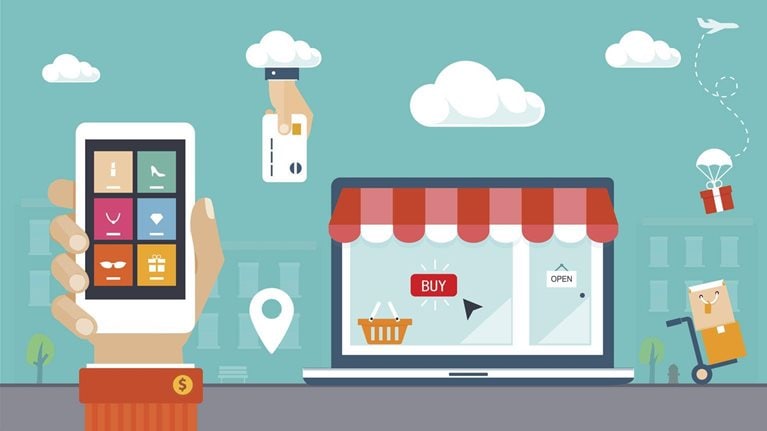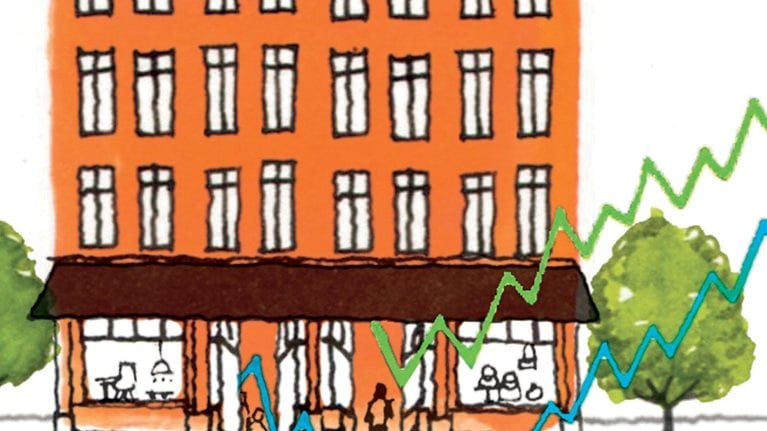The worlds of traditional commerce and e-commerce are merging. Devin Wenig, president of eBay Marketplaces—one of the world’s largest online markets—explains the impact of digitization on traditional retailers, bricks-and-mortar stores, the shopping experience, as well as the use of data to meet customers’ needs. This interview was conducted by McKinsey Publishing’s Simon London. An edited transcript of each of Wenig’s videos follows.
Omni everything
I just think we’ve hit an inflection point where technology is now so pervasive and so useful that we’re past the tipping point. And the world of e-commerce and commerce are now just seamlessly merged, and everything is omnichannel. It’s not about the phone or the desktop or the store—it’s about all of those. I think the last two years in particular have been extraordinary in the sense that technology has deconstructed the retail industry.
I think e-commerce for many years was an interesting trend, but it was on the side, largely, of what was happening in retail. Today we don’t even know what e-commerce means. They’ve just come together, the on- and the offline. Now, every merchant, every retailer must have an omnichannel strategy or they won’t survive. That’s very different than even just 24 months ago.
Future of the store
I should say the death of the store has been greatly exaggerated. There will be a transformation of retail real estate, but not an end to it. You could step back and connect dots and say, “The world’s going to have e-commerce only” and that “stores are dead,” but we don’t see that future at all—in part because I don’t think consumers want that future. I think people like to shop and they like the serendipity of stores. Shopping is as much about entertainment and engagement as it is about utility.
I think stores are going to become as much distribution and fulfillment centers as they are full-fledged shopping experiences. I think that stores and malls are going to be highly technology enabled. Think of today—the square footage in a store needs to attract people in the door, it needs to have the right inventory at the right time, and it needs to have high service levels. That’s a very expensive model, and it’s a very inefficient model.
What e-commerce has shown is that, particularly down the tail, it’s a much better business model to be just in time. I think that there’s a pattern in there for the way stores will transform. They’ll become technology enabled so that you can go to a store and see enough inventory, but you may shop “shoppable windows.” We’re building those right now for retailers around the world.
You may end up hollowing out the real estate, where the showroom is a much smaller part of the footprint, and the inventory and the distribution center become more of that footprint. That uses the phone, and it creates local commerce economies.
So I think that there are going to be stores, and I think that retail real estate is not dead, but it is going to transform, and it’s going to happen faster than people think. Within 24 months, you will see a fundamental restructuring of retail real estate—you will see distribution centers, local economies, technology-enabled shopping, and a very different approach toward how you engage with the consumer.
Beyond mobile
The latest trend has been that mobile is very important. I think we’re already past the mobile tipping point, where mobile is increasingly not a meaningful concept. It was only a few years ago that there were no tablets and there weren’t any smartphones. Now we’re very quickly moving to a world where we just think there will be technology-enabled screens, connected screens, of all sizes.
Some of them may be in a retail location, some of them will be on your wrist, some of them you may hold. I don’t know what mobile means anymore. Nobody has an electricity department in their company; nobody has an Internet department anymore—although they did a few years ago. I suspect that within 24 months, no one will have a mobile strategy. They’ll just have an omnichannel, connected-screens strategy.
New skills
Building engaging experiences across channels is incredibly important. Many retailers have spent their entire lives thinking about how to build an engaging experience in one channel, which is the store. But now, understanding how to connect with your core customers across every way they want to connect—not the way you want them to connect but the way they want to connect with you—is a different skill.
It requires design and product management. It requires understanding how to market in a digital world. There are still many instances that I see where it is old-school marketing. It’s still about major TV campaigns, get people into the stores. That’s still important, and that’s not going to go away.
But understanding how to engage in a world of exploding social networks, how to use search, how to use catalog, how to optimize, and how to engage—very different skills. I think that is going to become a core part of the playbook for retailers and merchants of all sizes around the world.
Data as competitive advantage
Various channels have advantages today; eBay, for one, has a selection advantage. We’re the world’s biggest store, and we have more things for sale than anyone else. But I think that’s going to go away. I think that in this omnichannel world—imagine, for planning purposes, that everything is for sale in every marketplace, every means, and every channel. We may never get to that world, but it’s a useful planning assumption.
So what’s left in that world? How do you compete and how do you build a barrier around your business? I think the answer is data. I think that the sustainable advantage of a retailer or a digital-commerce business is data. What data can do is to allow you to connect this exploding inventory, exploding selection that we’re all seeing, down to be a highly relevant experience for a consumer.
While from the merchant standpoint incredible selection may seem great, from the consumer standpoint it can be overwhelming. I actually don’t want to shop in a store with a billion items for sale, I’m just looking for this. Data is the way to connect a long-tail advantage with consumers that oftentimes want simplicity.
It’s easier said than done, but you’re starting now, in the industry, to see really good examples of businesses that are using data to their advantage. It’s certainly an incredibly important part of what we’re trying to do here at eBay.
Art and science
Great data is both art and science. There’s a lot of press about the science; there’s not as much about the art. But the truth is that judgment matters a lot. I could create an infinite number of segments and an infinite number of possibilities from our data, but creating an infinite number of possibilities isn’t an actionable strategy.
We use a lot of judgment, and we bring quantitative analysis to that to say, “The right way to look at our customers is this, not this,” even though there are infinite ways we could. So we have people that have a lot of experience. We’ve brought people into our data groups that actually did things like ran stores, so they have human insight and judgment. We have brilliant mathematicians who can run regression with the best of them. And somewhere in that mix we’re creating actionable insights, which is the only thing that this is about.
Small data
It’s not about big data, it’s about small data. Big data is useless. Big data is about big data sets that represent large groups of people and large behaviors. But in the world that I mentioned before, it’s about me connecting with you, my business connecting with you. You don’t want to be part of a big data set; you’re just looking to buy a shirt.
And that’s about small data. That’s about understanding insights that I can glean about you that don’t feel intrusive, don’t feel creepy, and don’t feel artificial—but feel natural. That, to me, is the future. There are glimmers of success there. I wouldn’t say the industry has arrived. For all the rhetoric about data, it’s a work in progress, but a critically important work in progress.
Can e-commerce inspire?
E-commerce has historically been incredibly search based because it’s fulfilling a utilitarian function. I know I want exactly this, so I put it in a search bar, and I’ll put it into a marketplace that I trust, like eBay or others. And I’ll either find that item or not, and if I find it, I’ll buy it.
Stores have had an important element of serendipity. I go to the store because I kind of want a shirt, but I’m not exactly sure what shirt I want—I may have an idea, but I like to browse. And inspiration matters, particularly in emotional categories like fashion.
The future of digital commerce is trying to get the best of both. Search is still incredibly important to us; people come to eBay, they’re looking for something. But as we bring curators in, and as we begin to create collections of beautiful items—we’re trying to spur inspiration, and we’re trying to spur imagination. We’re trying to capture some of what happens in stores, which is, “I went into a store to buy a shirt, and I also bought a pair of pants—didn’t know that I wanted it.” We’re seeing real success there.
It’s early days, but there’s no reason that digital shopping can’t be both utilitarian and inspiring, and I think that’s the next wave. But to do that effectively, data won’t get you there, because data tends to narrow you toward what you want. It’s not yet great at inspiring you as to what you may not have known you want, but you do after you see it.


